tires FORD ECOSPORT 2018 Owners Manual
[x] Cancel search | Manufacturer: FORD, Model Year: 2018, Model line: ECOSPORT, Model: FORD ECOSPORT 2018Pages: 452, PDF Size: 17.04 MB
Page 8 of 452
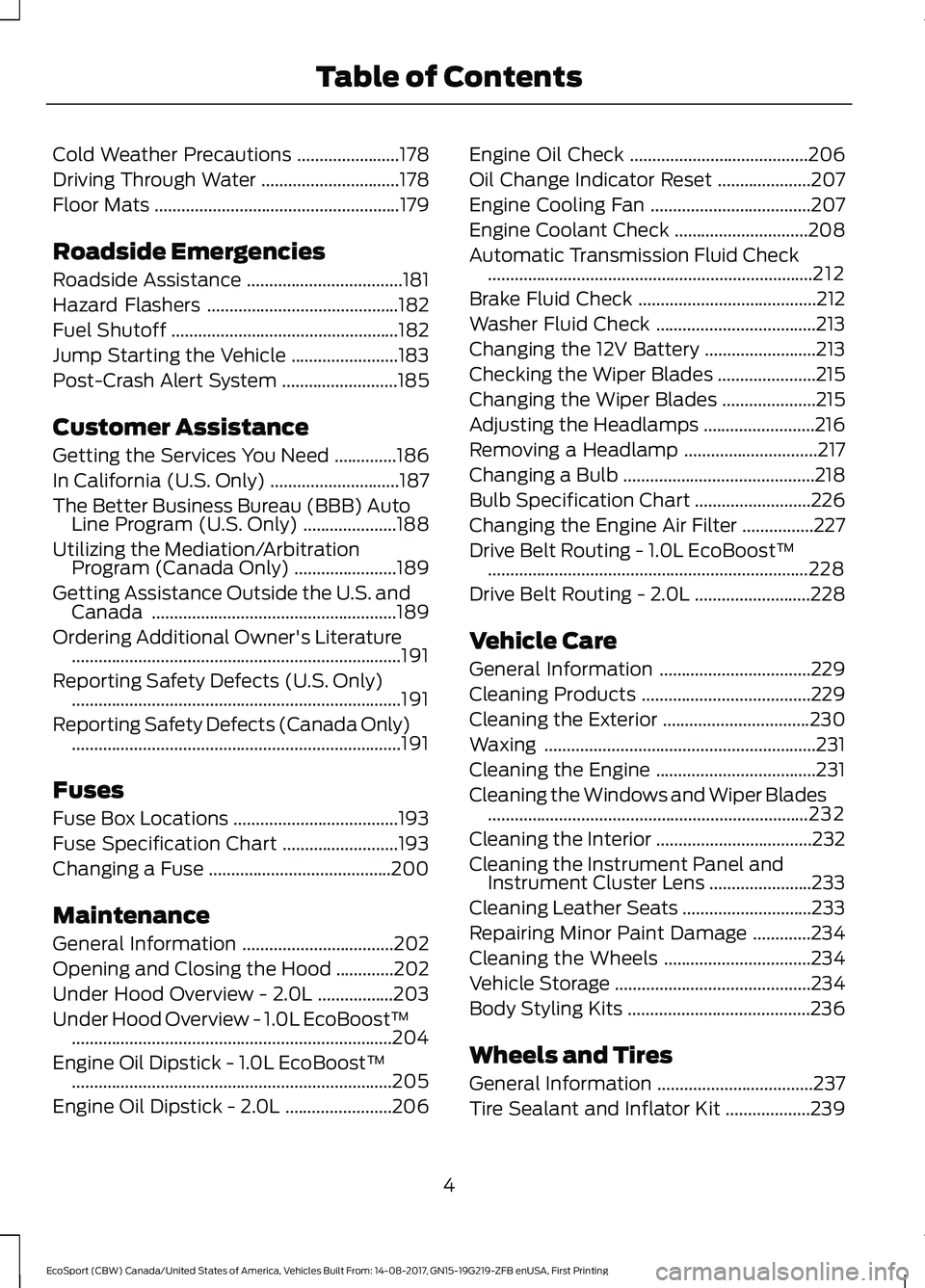
Cold Weather Precautions.......................178
Driving Through Water...............................178
Floor Mats.......................................................179
Roadside Emergencies
Roadside Assistance...................................181
Hazard Flashers...........................................182
Fuel Shutoff...................................................182
Jump Starting the Vehicle........................183
Post-Crash Alert System..........................185
Customer Assistance
Getting the Services You Need..............186
In California (U.S. Only).............................187
The Better Business Bureau (BBB) AutoLine Program (U.S. Only).....................188
Utilizing the Mediation/ArbitrationProgram (Canada Only).......................189
Getting Assistance Outside the U.S. andCanada.......................................................189
Ordering Additional Owner's Literature..........................................................................191
Reporting Safety Defects (U.S. Only)..........................................................................191
Reporting Safety Defects (Canada Only)..........................................................................191
Fuses
Fuse Box Locations.....................................193
Fuse Specification Chart..........................193
Changing a Fuse.........................................200
Maintenance
General Information..................................202
Opening and Closing the Hood.............202
Under Hood Overview - 2.0L.................203
Under Hood Overview - 1.0L EcoBoost™........................................................................204
Engine Oil Dipstick - 1.0L EcoBoost™........................................................................205
Engine Oil Dipstick - 2.0L........................206
Engine Oil Check........................................206
Oil Change Indicator Reset.....................207
Engine Cooling Fan....................................207
Engine Coolant Check..............................208
Automatic Transmission Fluid Check.........................................................................212
Brake Fluid Check........................................212
Washer Fluid Check....................................213
Changing the 12V Battery.........................213
Checking the Wiper Blades......................215
Changing the Wiper Blades.....................215
Adjusting the Headlamps.........................216
Removing a Headlamp..............................217
Changing a Bulb...........................................218
Bulb Specification Chart..........................226
Changing the Engine Air Filter................227
Drive Belt Routing - 1.0L EcoBoost™........................................................................228
Drive Belt Routing - 2.0L..........................228
Vehicle Care
General Information..................................229
Cleaning Products......................................229
Cleaning the Exterior.................................230
Waxing.............................................................231
Cleaning the Engine....................................231
Cleaning the Windows and Wiper Blades........................................................................232
Cleaning the Interior...................................232
Cleaning the Instrument Panel andInstrument Cluster Lens.......................233
Cleaning Leather Seats.............................233
Repairing Minor Paint Damage.............234
Cleaning the Wheels.................................234
Vehicle Storage............................................234
Body Styling Kits.........................................236
Wheels and Tires
General Information...................................237
Tire Sealant and Inflator Kit...................239
4EcoSport (CBW) Canada/United States of America, Vehicles Built From: 14-08-2017, GN15-19G219-ZFB enUSA, First PrintingTable of Contents
Page 9 of 452
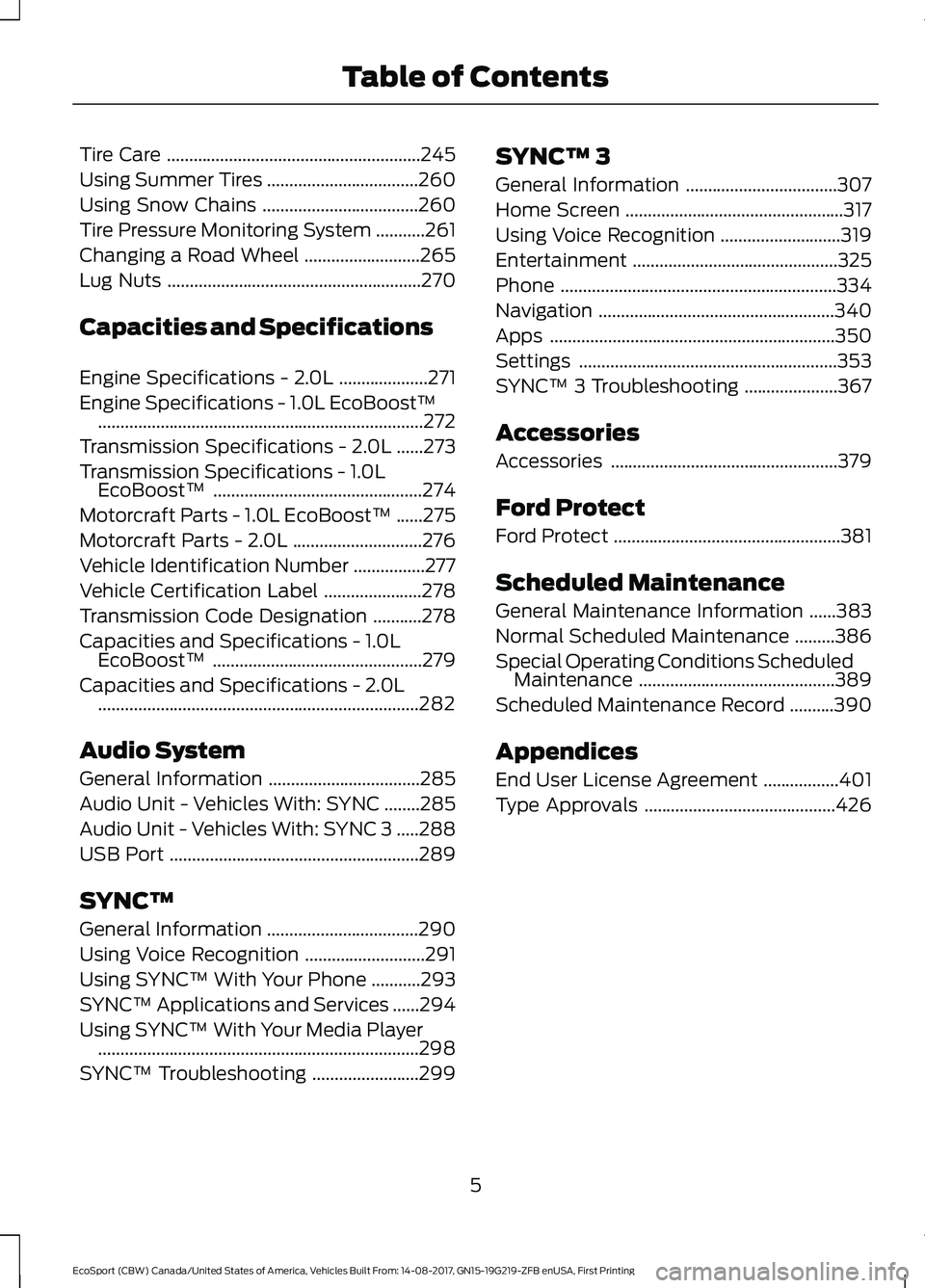
Tire Care.........................................................245
Using Summer Tires..................................260
Using Snow Chains...................................260
Tire Pressure Monitoring System...........261
Changing a Road Wheel..........................265
Lug Nuts.........................................................270
Capacities and Specifications
Engine Specifications - 2.0L....................271
Engine Specifications - 1.0L EcoBoost™.........................................................................272
Transmission Specifications - 2.0L......273
Transmission Specifications - 1.0LEcoBoost™...............................................274
Motorcraft Parts - 1.0L EcoBoost™......275
Motorcraft Parts - 2.0L.............................276
Vehicle Identification Number................277
Vehicle Certification Label......................278
Transmission Code Designation...........278
Capacities and Specifications - 1.0LEcoBoost™...............................................279
Capacities and Specifications - 2.0L........................................................................282
Audio System
General Information..................................285
Audio Unit - Vehicles With: SYNC........285
Audio Unit - Vehicles With: SYNC 3.....288
USB Port........................................................289
SYNC™
General Information..................................290
Using Voice Recognition...........................291
Using SYNC™ With Your Phone...........293
SYNC™ Applications and Services......294
Using SYNC™ With Your Media Player........................................................................298
SYNC™ Troubleshooting........................299
SYNC™ 3
General Information..................................307
Home Screen.................................................317
Using Voice Recognition...........................319
Entertainment..............................................325
Phone..............................................................334
Navigation.....................................................340
Apps................................................................350
Settings..........................................................353
SYNC™ 3 Troubleshooting.....................367
Accessories
Accessories...................................................379
Ford Protect
Ford Protect...................................................381
Scheduled Maintenance
General Maintenance Information......383
Normal Scheduled Maintenance.........386
Special Operating Conditions ScheduledMaintenance............................................389
Scheduled Maintenance Record..........390
Appendices
End User License Agreement.................401
Type Approvals...........................................426
5EcoSport (CBW) Canada/United States of America, Vehicles Built From: 14-08-2017, GN15-19G219-ZFB enUSA, First PrintingTable of Contents
Page 87 of 452
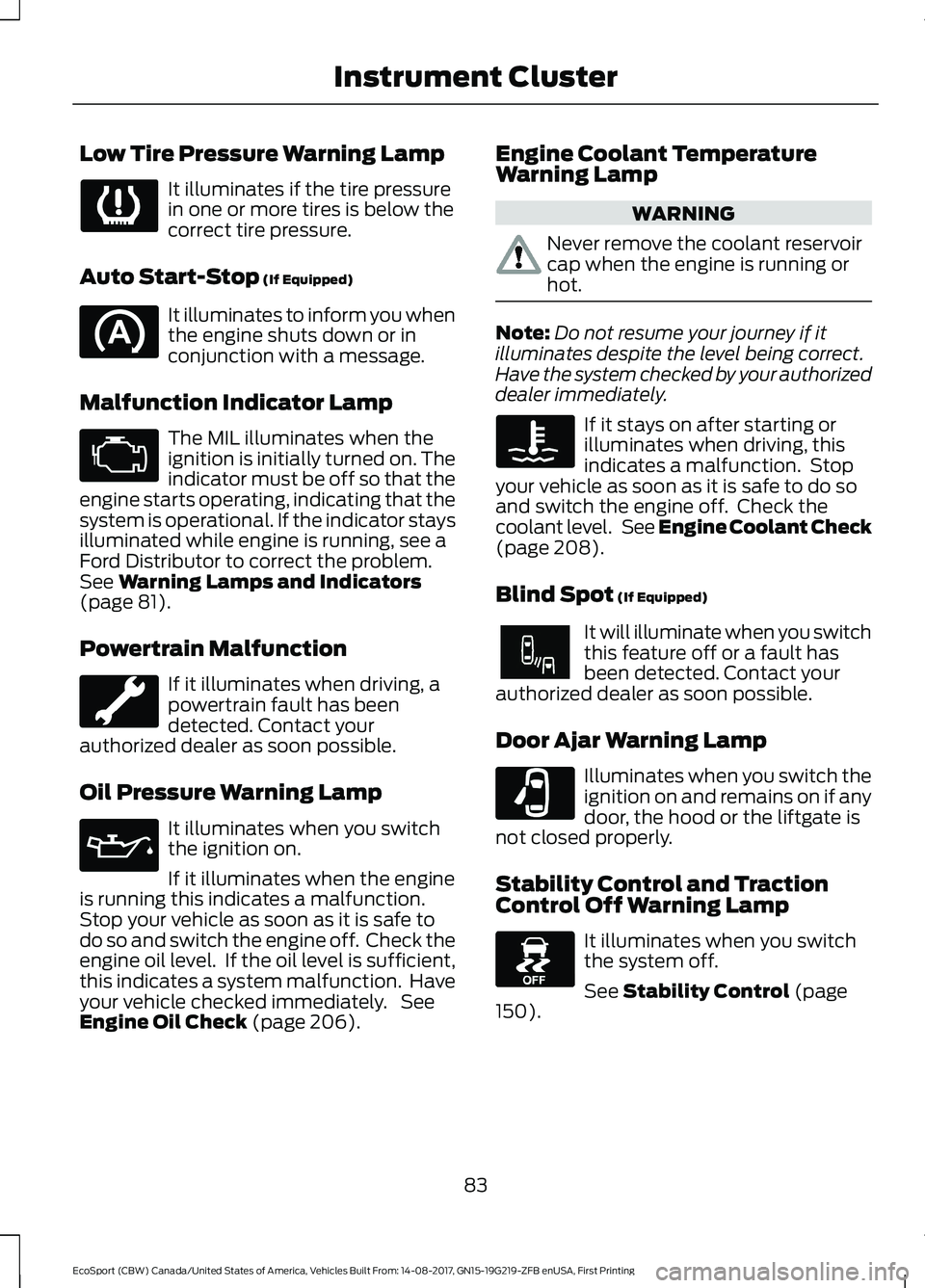
Low Tire Pressure Warning Lamp
It illuminates if the tire pressurein one or more tires is below thecorrect tire pressure.
Auto Start-Stop (If Equipped)
It illuminates to inform you whenthe engine shuts down or inconjunction with a message.
Malfunction Indicator Lamp
The MIL illuminates when theignition is initially turned on. Theindicator must be off so that theengine starts operating, indicating that thesystem is operational. If the indicator staysilluminated while engine is running, see aFord Distributor to correct the problem.See Warning Lamps and Indicators(page 81).
Powertrain Malfunction
If it illuminates when driving, apowertrain fault has beendetected. Contact yourauthorized dealer as soon possible.
Oil Pressure Warning Lamp
It illuminates when you switchthe ignition on.
If it illuminates when the engineis running this indicates a malfunction.Stop your vehicle as soon as it is safe todo so and switch the engine off. Check theengine oil level. If the oil level is sufficient,this indicates a system malfunction. Haveyour vehicle checked immediately. SeeEngine Oil Check (page 206).
Engine Coolant TemperatureWarning Lamp
WARNING
Never remove the coolant reservoircap when the engine is running orhot.
Note:Do not resume your journey if itilluminates despite the level being correct.Have the system checked by your authorizeddealer immediately.
If it stays on after starting orilluminates when driving, thisindicates a malfunction. Stopyour vehicle as soon as it is safe to do soand switch the engine off. Check thecoolant level. See Engine Coolant Check(page 208).
Blind Spot (If Equipped)
It will illuminate when you switchthis feature off or a fault hasbeen detected. Contact yourauthorized dealer as soon possible.
Door Ajar Warning Lamp
Illuminates when you switch theignition on and remains on if anydoor, the hood or the liftgate isnot closed properly.
Stability Control and TractionControl Off Warning Lamp
It illuminates when you switchthe system off.
See Stability Control (page150).
83EcoSport (CBW) Canada/United States of America, Vehicles Built From: 14-08-2017, GN15-19G219-ZFB enUSA, First PrintingInstrument Cluster
Page 94 of 452
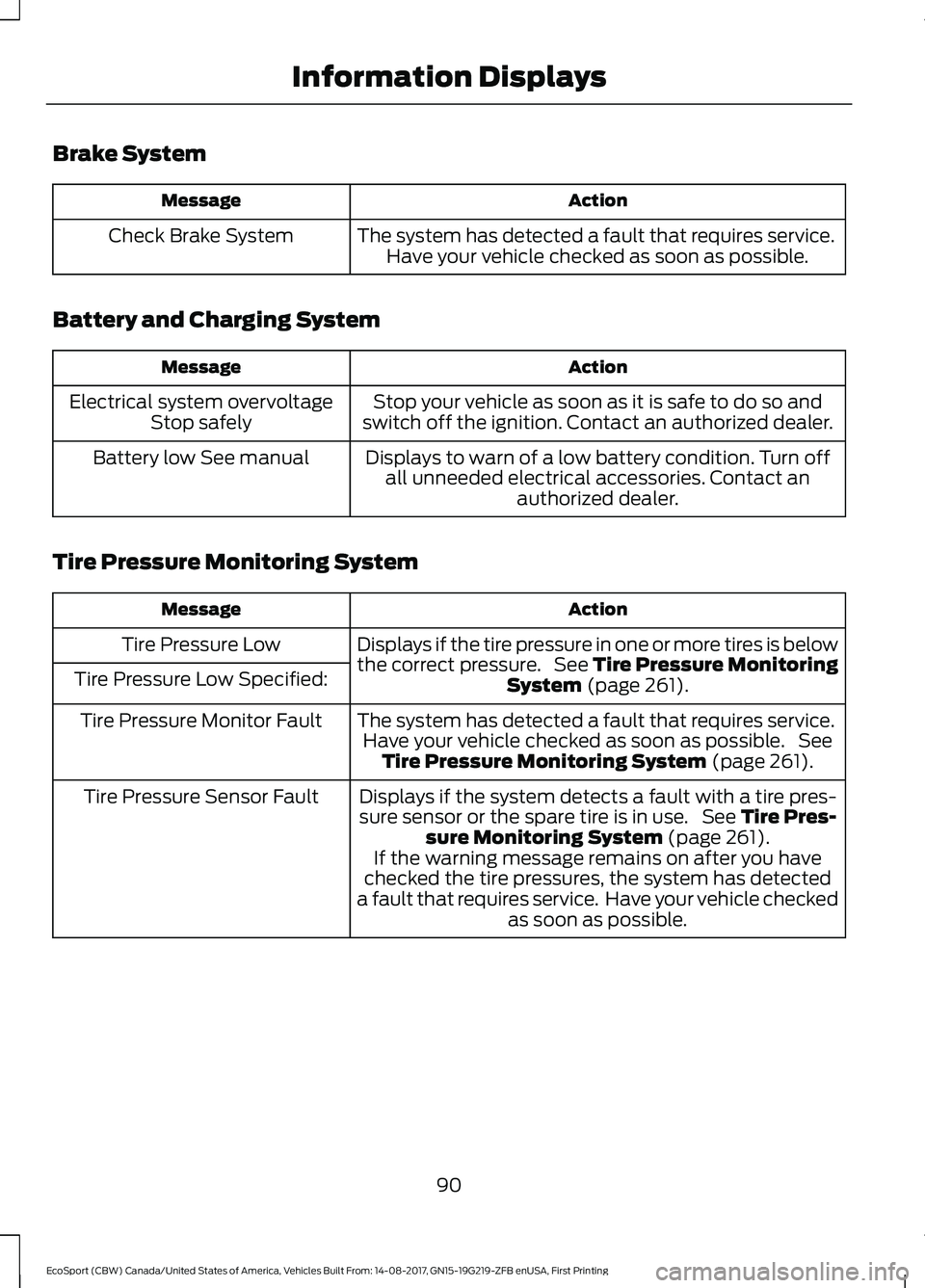
Brake System
ActionMessage
The system has detected a fault that requires service.Have your vehicle checked as soon as possible.Check Brake System
Battery and Charging System
ActionMessage
Stop your vehicle as soon as it is safe to do so andswitch off the ignition. Contact an authorized dealer.Electrical system overvoltageStop safely
Displays to warn of a low battery condition. Turn offall unneeded electrical accessories. Contact anauthorized dealer.
Battery low See manual
Tire Pressure Monitoring System
ActionMessage
Displays if the tire pressure in one or more tires is belowthe correct pressure. See Tire Pressure MonitoringSystem (page 261).
Tire Pressure Low
Tire Pressure Low Specified:
The system has detected a fault that requires service.Have your vehicle checked as soon as possible. SeeTire Pressure Monitoring System (page 261).
Tire Pressure Monitor Fault
Displays if the system detects a fault with a tire pres-sure sensor or the spare tire is in use. See Tire Pres-sure Monitoring System (page 261).If the warning message remains on after you havechecked the tire pressures, the system has detecteda fault that requires service. Have your vehicle checkedas soon as possible.
Tire Pressure Sensor Fault
90EcoSport (CBW) Canada/United States of America, Vehicles Built From: 14-08-2017, GN15-19G219-ZFB enUSA, First PrintingInformation Displays
Page 145 of 452
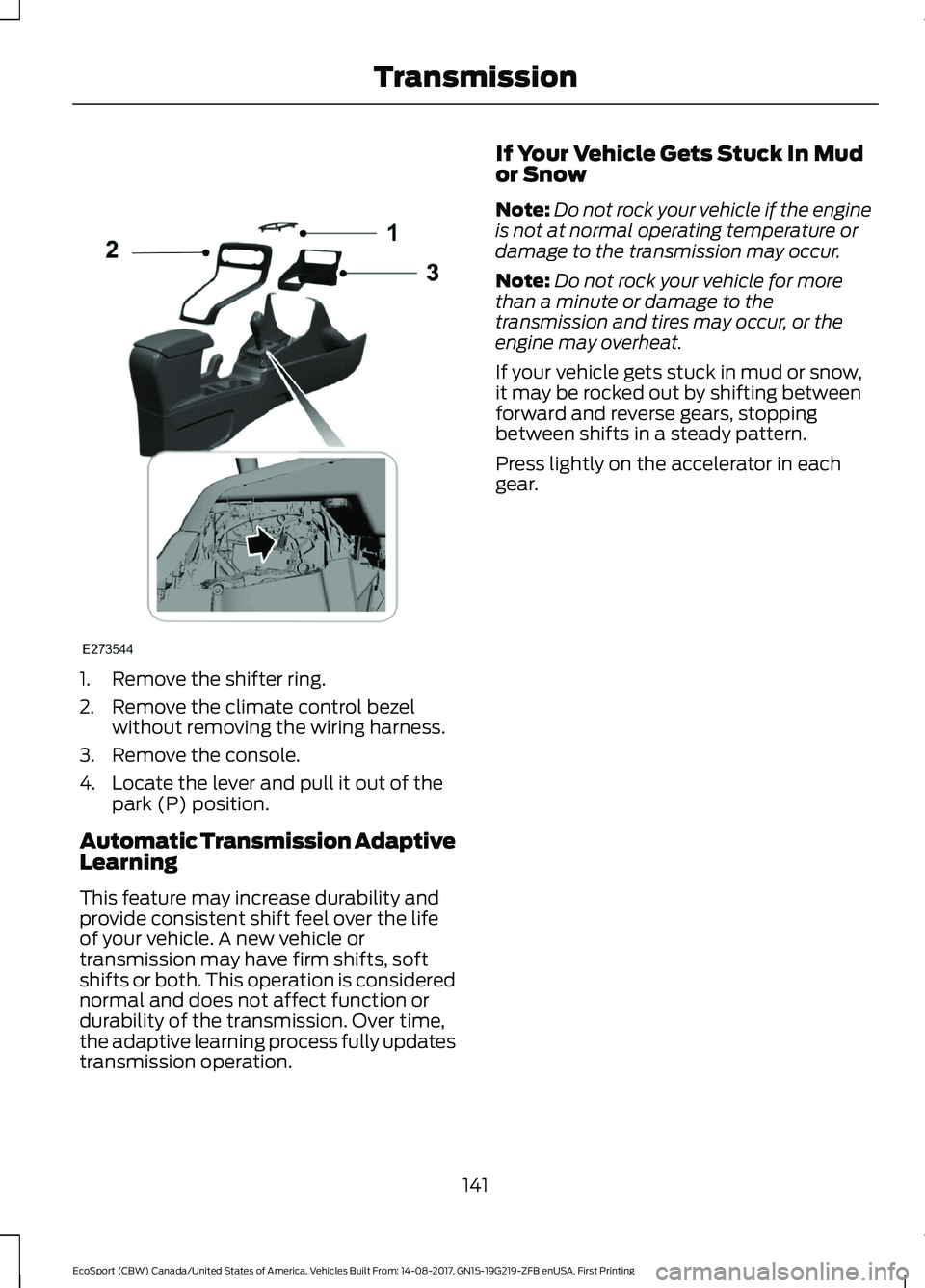
1.Remove the shifter ring.
2.Remove the climate control bezelwithout removing the wiring harness.
3.Remove the console.
4.Locate the lever and pull it out of thepark (P) position.
Automatic Transmission AdaptiveLearning
This feature may increase durability andprovide consistent shift feel over the lifeof your vehicle. A new vehicle ortransmission may have firm shifts, softshifts or both. This operation is considerednormal and does not affect function ordurability of the transmission. Over time,the adaptive learning process fully updatestransmission operation.
If Your Vehicle Gets Stuck In Mudor Snow
Note:Do not rock your vehicle if the engineis not at normal operating temperature ordamage to the transmission may occur.
Note:Do not rock your vehicle for morethan a minute or damage to thetransmission and tires may occur, or theengine may overheat.
If your vehicle gets stuck in mud or snow,it may be rocked out by shifting betweenforward and reverse gears, stoppingbetween shifts in a steady pattern.
Press lightly on the accelerator in eachgear.
141EcoSport (CBW) Canada/United States of America, Vehicles Built From: 14-08-2017, GN15-19G219-ZFB enUSA, First PrintingTransmission
Page 146 of 452
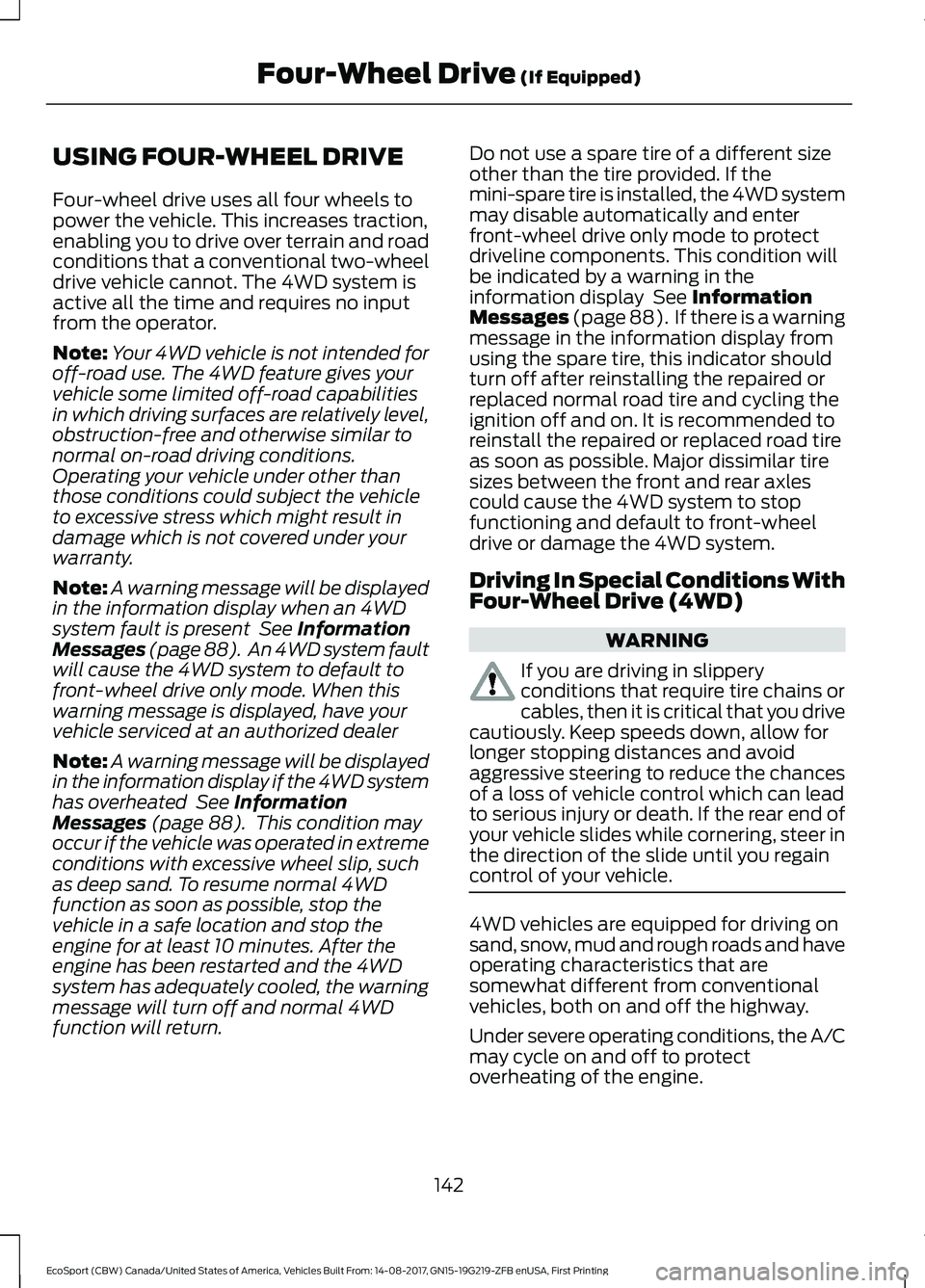
USING FOUR-WHEEL DRIVE
Four-wheel drive uses all four wheels topower the vehicle. This increases traction,enabling you to drive over terrain and roadconditions that a conventional two-wheeldrive vehicle cannot. The 4WD system isactive all the time and requires no inputfrom the operator.
Note:Your 4WD vehicle is not intended foroff-road use. The 4WD feature gives yourvehicle some limited off-road capabilitiesin which driving surfaces are relatively level,obstruction-free and otherwise similar tonormal on-road driving conditions.Operating your vehicle under other thanthose conditions could subject the vehicleto excessive stress which might result indamage which is not covered under yourwarranty.
Note:A warning message will be displayedin the information display when an 4WDsystem fault is present See InformationMessages (page 88). An 4WD system faultwill cause the 4WD system to default tofront-wheel drive only mode. When thiswarning message is displayed, have yourvehicle serviced at an authorized dealer
Note:A warning message will be displayedin the information display if the 4WD systemhas overheated See InformationMessages (page 88). This condition mayoccur if the vehicle was operated in extremeconditions with excessive wheel slip, suchas deep sand. To resume normal 4WDfunction as soon as possible, stop thevehicle in a safe location and stop theengine for at least 10 minutes. After theengine has been restarted and the 4WDsystem has adequately cooled, the warningmessage will turn off and normal 4WDfunction will return.
Do not use a spare tire of a different sizeother than the tire provided. If themini-spare tire is installed, the 4WD systemmay disable automatically and enterfront-wheel drive only mode to protectdriveline components. This condition willbe indicated by a warning in theinformation display See InformationMessages (page 88). If there is a warningmessage in the information display fromusing the spare tire, this indicator shouldturn off after reinstalling the repaired orreplaced normal road tire and cycling theignition off and on. It is recommended toreinstall the repaired or replaced road tireas soon as possible. Major dissimilar tiresizes between the front and rear axlescould cause the 4WD system to stopfunctioning and default to front-wheeldrive or damage the 4WD system.
Driving In Special Conditions WithFour-Wheel Drive (4WD)
WARNING
If you are driving in slipperyconditions that require tire chains orcables, then it is critical that you drivecautiously. Keep speeds down, allow forlonger stopping distances and avoidaggressive steering to reduce the chancesof a loss of vehicle control which can leadto serious injury or death. If the rear end ofyour vehicle slides while cornering, steer inthe direction of the slide until you regaincontrol of your vehicle.
4WD vehicles are equipped for driving onsand, snow, mud and rough roads and haveoperating characteristics that aresomewhat different from conventionalvehicles, both on and off the highway.
Under severe operating conditions, the A/Cmay cycle on and off to protectoverheating of the engine.
142EcoSport (CBW) Canada/United States of America, Vehicles Built From: 14-08-2017, GN15-19G219-ZFB enUSA, First PrintingFour-Wheel Drive (If Equipped)
Page 147 of 452
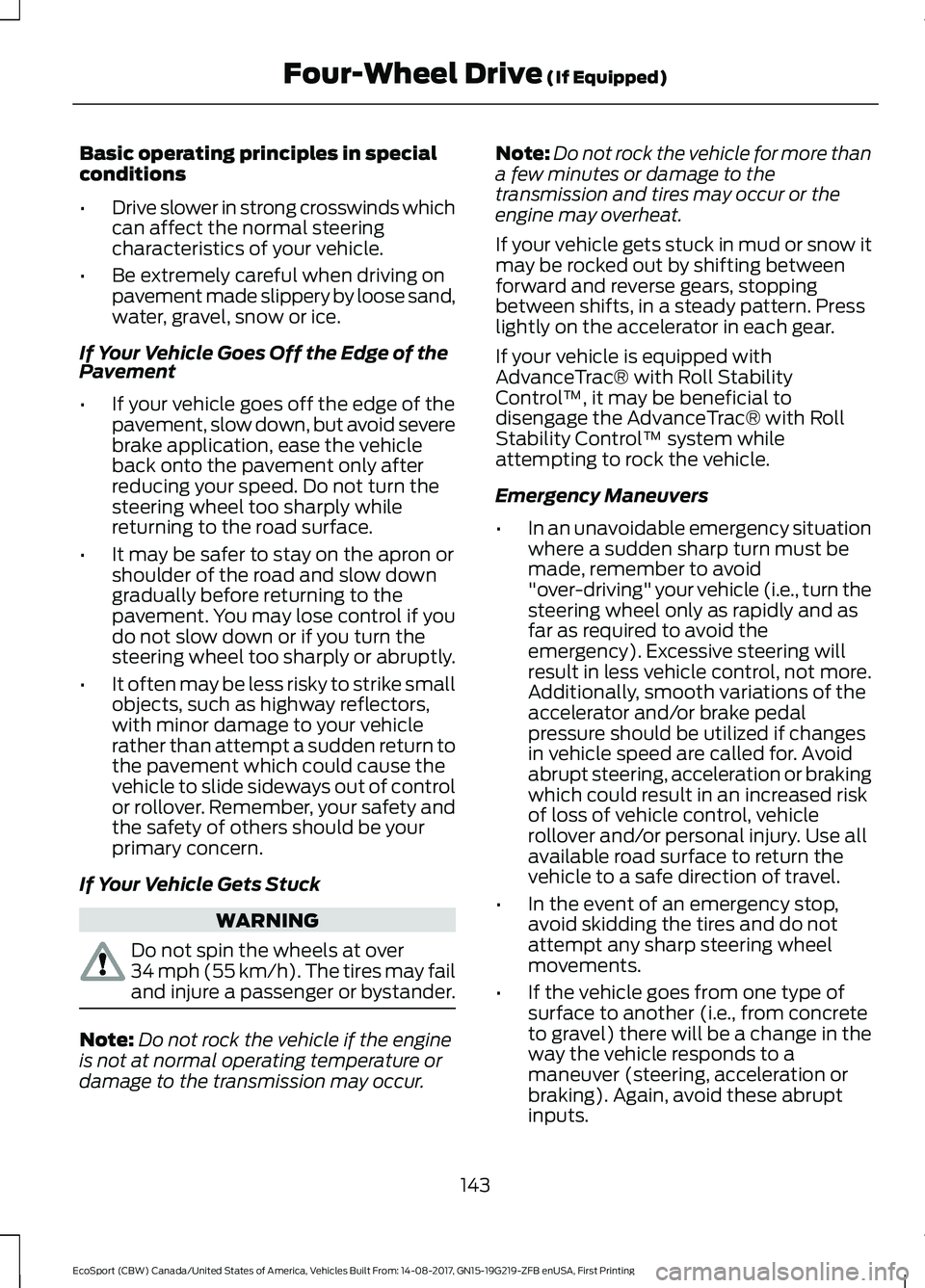
Basic operating principles in specialconditions
•Drive slower in strong crosswinds whichcan affect the normal steeringcharacteristics of your vehicle.
•Be extremely careful when driving onpavement made slippery by loose sand,water, gravel, snow or ice.
If Your Vehicle Goes Off the Edge of thePavement
•If your vehicle goes off the edge of thepavement, slow down, but avoid severebrake application, ease the vehicleback onto the pavement only afterreducing your speed. Do not turn thesteering wheel too sharply whilereturning to the road surface.
•It may be safer to stay on the apron orshoulder of the road and slow downgradually before returning to thepavement. You may lose control if youdo not slow down or if you turn thesteering wheel too sharply or abruptly.
•It often may be less risky to strike smallobjects, such as highway reflectors,with minor damage to your vehiclerather than attempt a sudden return tothe pavement which could cause thevehicle to slide sideways out of controlor rollover. Remember, your safety andthe safety of others should be yourprimary concern.
If Your Vehicle Gets Stuck
WARNING
Do not spin the wheels at over34 mph (55 km/h). The tires may failand injure a passenger or bystander.
Note:Do not rock the vehicle if the engineis not at normal operating temperature ordamage to the transmission may occur.
Note:Do not rock the vehicle for more thana few minutes or damage to thetransmission and tires may occur or theengine may overheat.
If your vehicle gets stuck in mud or snow itmay be rocked out by shifting betweenforward and reverse gears, stoppingbetween shifts, in a steady pattern. Presslightly on the accelerator in each gear.
If your vehicle is equipped withAdvanceTrac® with Roll StabilityControl™, it may be beneficial todisengage the AdvanceTrac® with RollStability Control™ system whileattempting to rock the vehicle.
Emergency Maneuvers
•In an unavoidable emergency situationwhere a sudden sharp turn must bemade, remember to avoid"over-driving" your vehicle (i.e., turn thesteering wheel only as rapidly and asfar as required to avoid theemergency). Excessive steering willresult in less vehicle control, not more.Additionally, smooth variations of theaccelerator and/or brake pedalpressure should be utilized if changesin vehicle speed are called for. Avoidabrupt steering, acceleration or brakingwhich could result in an increased riskof loss of vehicle control, vehiclerollover and/or personal injury. Use allavailable road surface to return thevehicle to a safe direction of travel.
•In the event of an emergency stop,avoid skidding the tires and do notattempt any sharp steering wheelmovements.
•If the vehicle goes from one type ofsurface to another (i.e., from concreteto gravel) there will be a change in theway the vehicle responds to amaneuver (steering, acceleration orbraking). Again, avoid these abruptinputs.
143EcoSport (CBW) Canada/United States of America, Vehicles Built From: 14-08-2017, GN15-19G219-ZFB enUSA, First PrintingFour-Wheel Drive (If Equipped)
Page 148 of 452
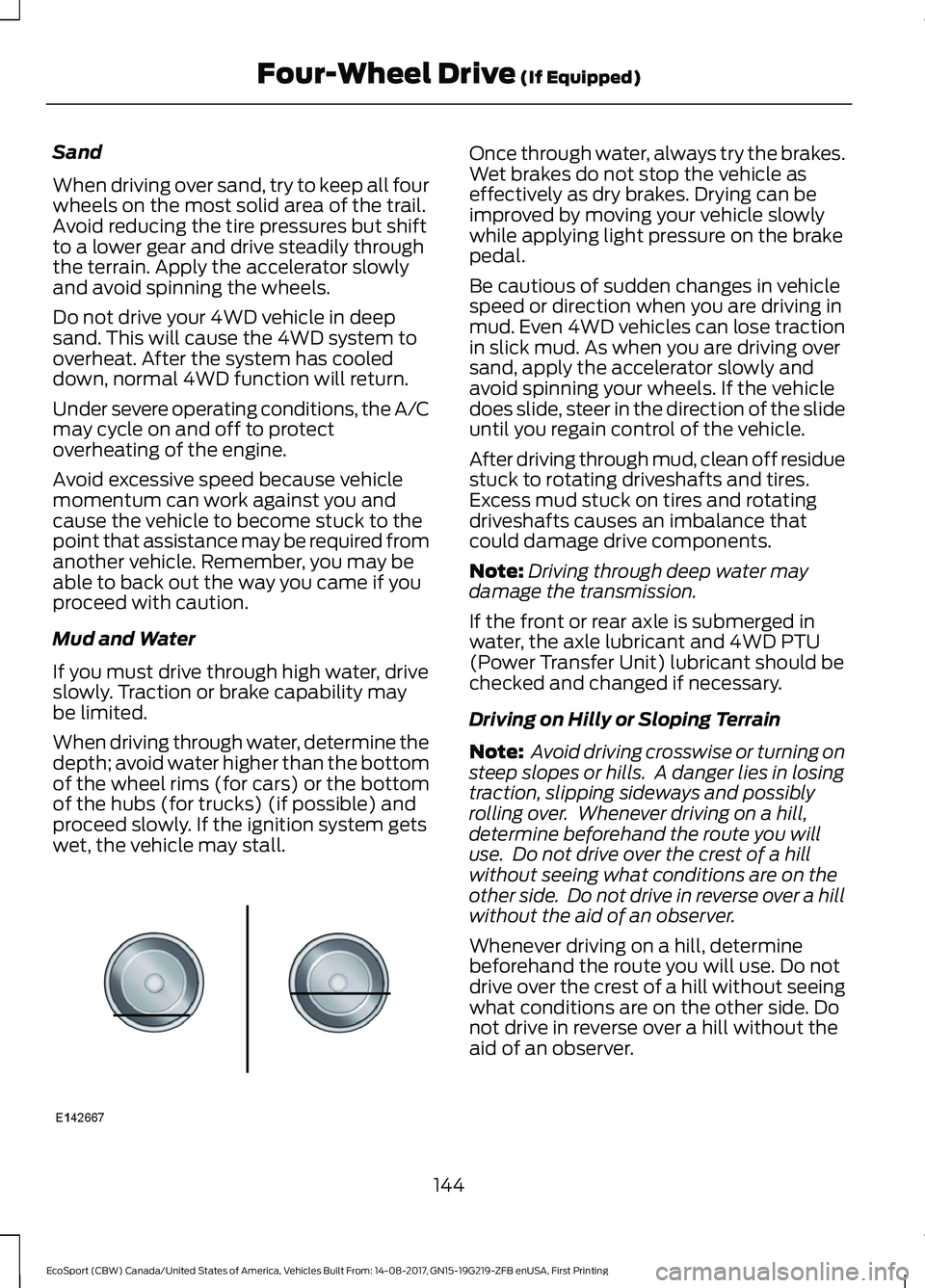
Sand
When driving over sand, try to keep all fourwheels on the most solid area of the trail.Avoid reducing the tire pressures but shiftto a lower gear and drive steadily throughthe terrain. Apply the accelerator slowlyand avoid spinning the wheels.
Do not drive your 4WD vehicle in deepsand. This will cause the 4WD system tooverheat. After the system has cooleddown, normal 4WD function will return.
Under severe operating conditions, the A/Cmay cycle on and off to protectoverheating of the engine.
Avoid excessive speed because vehiclemomentum can work against you andcause the vehicle to become stuck to thepoint that assistance may be required fromanother vehicle. Remember, you may beable to back out the way you came if youproceed with caution.
Mud and Water
If you must drive through high water, driveslowly. Traction or brake capability maybe limited.
When driving through water, determine thedepth; avoid water higher than the bottomof the wheel rims (for cars) or the bottomof the hubs (for trucks) (if possible) andproceed slowly. If the ignition system getswet, the vehicle may stall.
Once through water, always try the brakes.Wet brakes do not stop the vehicle aseffectively as dry brakes. Drying can beimproved by moving your vehicle slowlywhile applying light pressure on the brakepedal.
Be cautious of sudden changes in vehiclespeed or direction when you are driving inmud. Even 4WD vehicles can lose tractionin slick mud. As when you are driving oversand, apply the accelerator slowly andavoid spinning your wheels. If the vehicledoes slide, steer in the direction of the slideuntil you regain control of the vehicle.
After driving through mud, clean off residuestuck to rotating driveshafts and tires.Excess mud stuck on tires and rotatingdriveshafts causes an imbalance thatcould damage drive components.
Note:Driving through deep water maydamage the transmission.
If the front or rear axle is submerged inwater, the axle lubricant and 4WD PTU(Power Transfer Unit) lubricant should bechecked and changed if necessary.
Driving on Hilly or Sloping Terrain
Note: Avoid driving crosswise or turning onsteep slopes or hills. A danger lies in losingtraction, slipping sideways and possiblyrolling over. Whenever driving on a hill,determine beforehand the route you willuse. Do not drive over the crest of a hillwithout seeing what conditions are on theother side. Do not drive in reverse over a hillwithout the aid of an observer.
Whenever driving on a hill, determinebeforehand the route you will use. Do notdrive over the crest of a hill without seeingwhat conditions are on the other side. Donot drive in reverse over a hill without theaid of an observer.
144EcoSport (CBW) Canada/United States of America, Vehicles Built From: 14-08-2017, GN15-19G219-ZFB enUSA, First PrintingFour-Wheel Drive (If Equipped)
Page 149 of 452
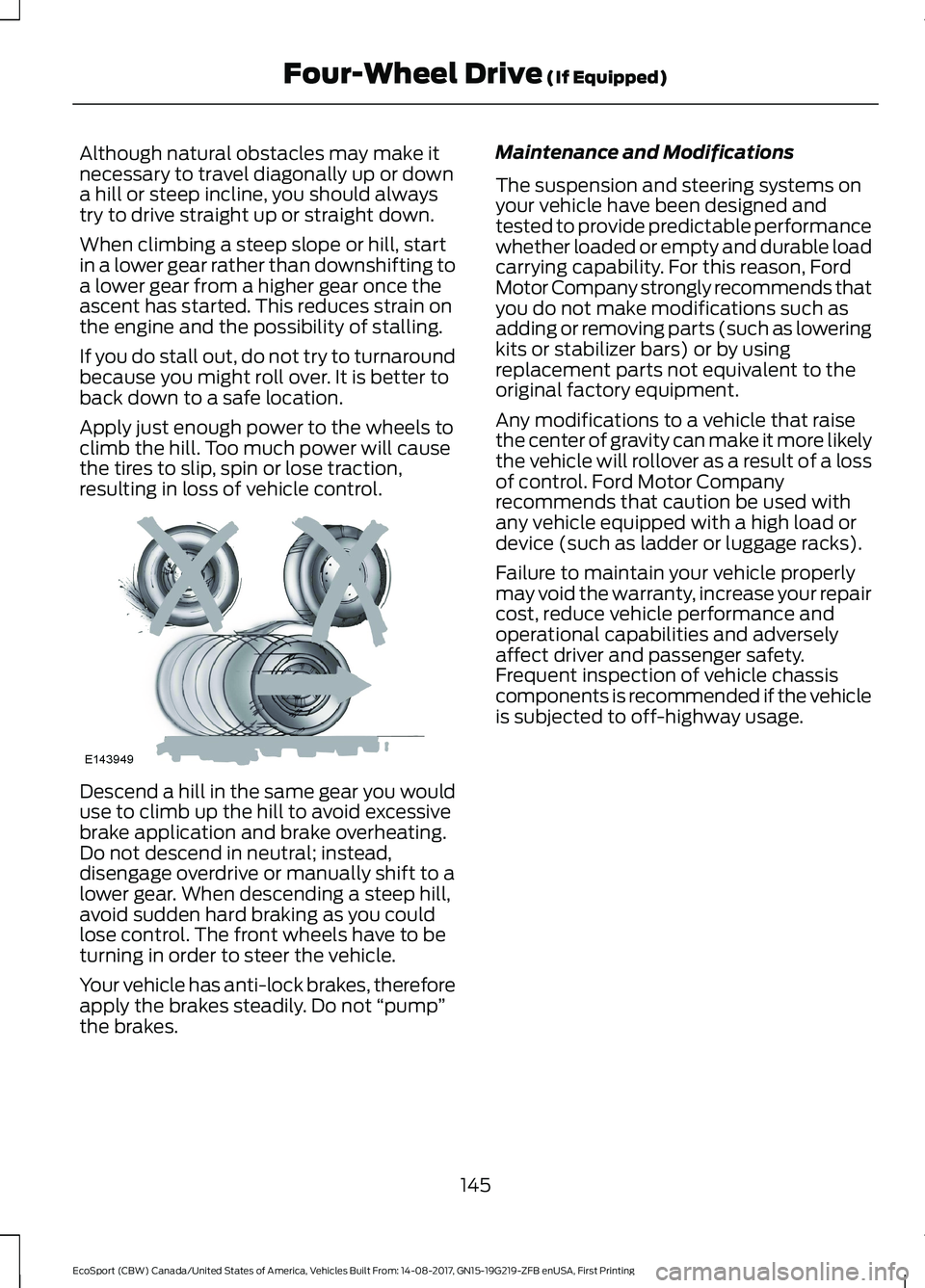
Although natural obstacles may make itnecessary to travel diagonally up or downa hill or steep incline, you should alwaystry to drive straight up or straight down.
When climbing a steep slope or hill, startin a lower gear rather than downshifting toa lower gear from a higher gear once theascent has started. This reduces strain onthe engine and the possibility of stalling.
If you do stall out, do not try to turnaroundbecause you might roll over. It is better toback down to a safe location.
Apply just enough power to the wheels toclimb the hill. Too much power will causethe tires to slip, spin or lose traction,resulting in loss of vehicle control.
Descend a hill in the same gear you woulduse to climb up the hill to avoid excessivebrake application and brake overheating.Do not descend in neutral; instead,disengage overdrive or manually shift to alower gear. When descending a steep hill,avoid sudden hard braking as you couldlose control. The front wheels have to beturning in order to steer the vehicle.
Your vehicle has anti-lock brakes, thereforeapply the brakes steadily. Do not “pump”the brakes.
Maintenance and Modifications
The suspension and steering systems onyour vehicle have been designed andtested to provide predictable performancewhether loaded or empty and durable loadcarrying capability. For this reason, FordMotor Company strongly recommends thatyou do not make modifications such asadding or removing parts (such as loweringkits or stabilizer bars) or by usingreplacement parts not equivalent to theoriginal factory equipment.
Any modifications to a vehicle that raisethe center of gravity can make it more likelythe vehicle will rollover as a result of a lossof control. Ford Motor Companyrecommends that caution be used withany vehicle equipped with a high load ordevice (such as ladder or luggage racks).
Failure to maintain your vehicle properlymay void the warranty, increase your repaircost, reduce vehicle performance andoperational capabilities and adverselyaffect driver and passenger safety.Frequent inspection of vehicle chassiscomponents is recommended if the vehicleis subjected to off-highway usage.
145EcoSport (CBW) Canada/United States of America, Vehicles Built From: 14-08-2017, GN15-19G219-ZFB enUSA, First PrintingFour-Wheel Drive (If Equipped)
Page 168 of 452
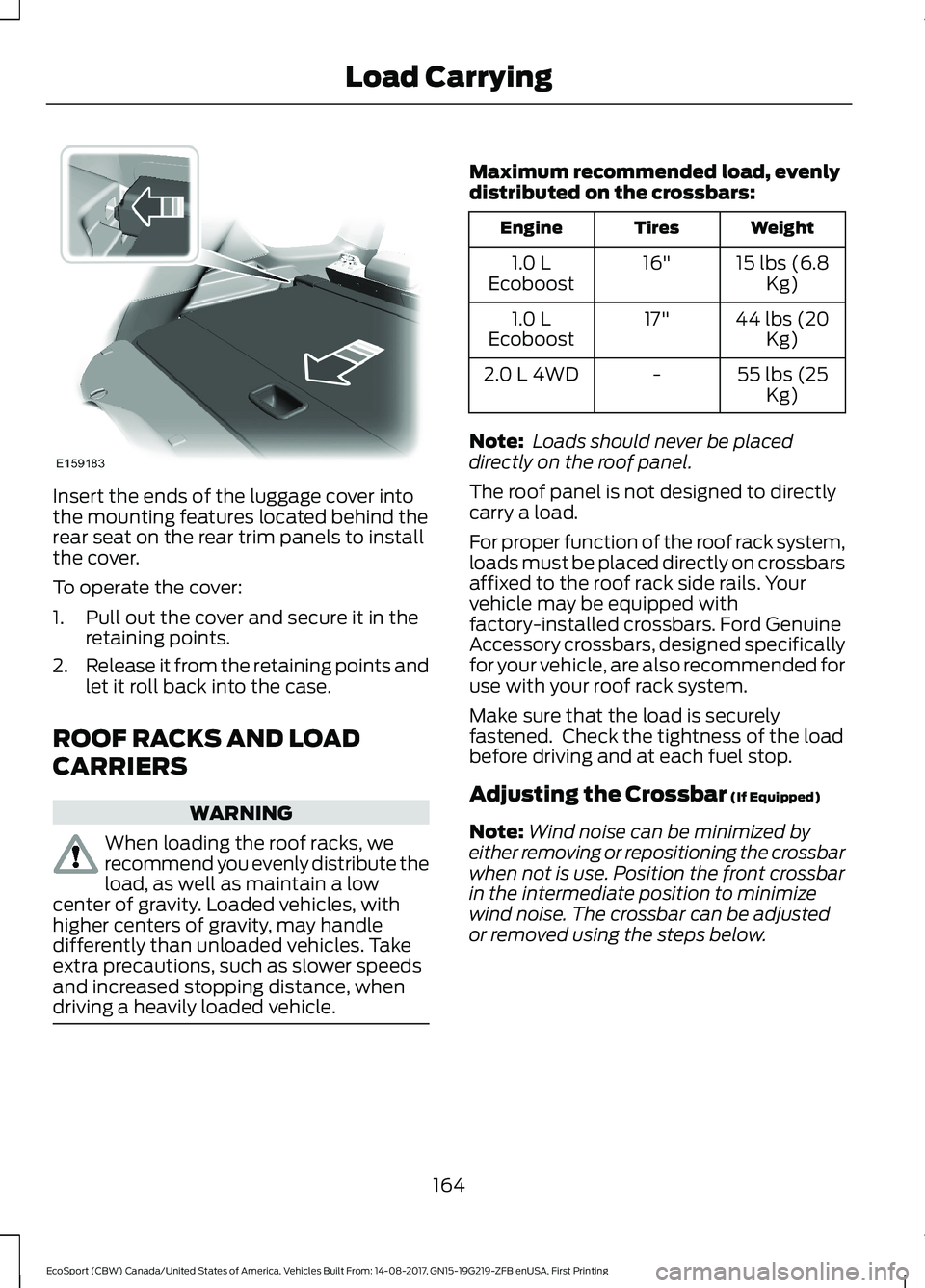
Insert the ends of the luggage cover intothe mounting features located behind therear seat on the rear trim panels to installthe cover.
To operate the cover:
1.Pull out the cover and secure it in theretaining points.
2.Release it from the retaining points andlet it roll back into the case.
ROOF RACKS AND LOAD
CARRIERS
WARNING
When loading the roof racks, werecommend you evenly distribute theload, as well as maintain a lowcenter of gravity. Loaded vehicles, withhigher centers of gravity, may handledifferently than unloaded vehicles. Takeextra precautions, such as slower speedsand increased stopping distance, whendriving a heavily loaded vehicle.
Maximum recommended load, evenlydistributed on the crossbars:
WeightTiresEngine
15 lbs (6.8Kg)16"1.0 LEcoboost
44 lbs (20Kg)17"1.0 LEcoboost
55 lbs (25Kg)-2.0 L 4WD
Note: Loads should never be placeddirectly on the roof panel.
The roof panel is not designed to directlycarry a load.
For proper function of the roof rack system,loads must be placed directly on crossbarsaffixed to the roof rack side rails. Yourvehicle may be equipped withfactory-installed crossbars. Ford GenuineAccessory crossbars, designed specificallyfor your vehicle, are also recommended foruse with your roof rack system.
Make sure that the load is securelyfastened. Check the tightness of the loadbefore driving and at each fuel stop.
Adjusting the Crossbar (If Equipped)
Note:Wind noise can be minimized byeither removing or repositioning the crossbarwhen not is use. Position the front crossbarin the intermediate position to minimizewind noise. The crossbar can be adjustedor removed using the steps below.
164EcoSport (CBW) Canada/United States of America, Vehicles Built From: 14-08-2017, GN15-19G219-ZFB enUSA, First PrintingLoad Carrying